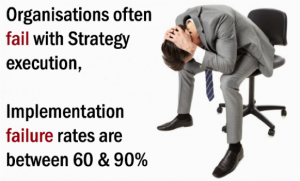Various sources have reported implementation failures at between 60 & 90%.
A citation from Robert Kaplan & David Norton emphasized on the importance of alignment in and between departments to enhance Synergy and to secure successful accomplishment of Strategy Objectives and execution of Improvement Action Plans.
Fragmented Management Processes
Consider a management calendar with diverse management processes done by different units at different times of the year without the guidance from an integrated, consistent view of strategy. The process starts sometime in the middle of the fiscal year, when the strategic planning department organizes a (multi-day offsite) meeting for the executive leadership team to update strategy based on a review of the company’s strengths, weaknesses, opportunities, and threats, and in light of changing circumstances. As valuable as these planning sessions are, executives lack a simple framework for communicating the updated strategy to others.
 Subsequently, individual business units and shared service units, such as human resources and information technology, do their own annual strategic planning updates. Research reveals that 67 % of HR and IT organizations are not aligned with business units and corporate strategies, therefore they do not reflect how the units must work together to achieve integration and synergy, and their departmental plans do not support corporate or business units’ strategic initiatives.
Subsequently, individual business units and shared service units, such as human resources and information technology, do their own annual strategic planning updates. Research reveals that 67 % of HR and IT organizations are not aligned with business units and corporate strategies, therefore they do not reflect how the units must work together to achieve integration and synergy, and their departmental plans do not support corporate or business units’ strategic initiatives.
During the third and fourth quarters, the finance department runs the annual budgeting process that authorizes next year’s spending on operations, discretionary programs, and capital investments, and establishes next year’s targets for financial metrics, such as revenues, expenses, operating margins, and profits. Again this process is typically uninformed by the strategic plan; 60 % of organizations do not link their financial budgets to strategic priorities.
At the end of the year, the human resources department runs annual performance reviews for all employees, determines their bonus and incentive awards, and has all employees update their objectives and plans for the subsequent year. But 70 % of middle managers and more than 90 % of front line employees do not have incentive compensation tied to successful strategy implementation.
 Throughout the subsequent year, senior executives meet at least monthly to review progress against the budget, and initiate actions to meet short-term targeted performance. Such discussions invariably focus on short-term operations, fire-fighting, and tactics. 85 % of executive leadership teams report that they spend less than one hour per month discussing their unit’s strategy and 50 % indicate they spend zero time on strategy discussions.
Throughout the subsequent year, senior executives meet at least monthly to review progress against the budget, and initiate actions to meet short-term targeted performance. Such discussions invariably focus on short-term operations, fire-fighting, and tactics. 85 % of executive leadership teams report that they spend less than one hour per month discussing their unit’s strategy and 50 % indicate they spend zero time on strategy discussions.
Meanwhile, the internal communications group sends continual messages to employees about the company. But these messages have little to do with business unit and corporate strategy. 95 % of employees claim they are not aware of, or do not understand the strategy. If employees who are closest to the customers and who operate the processes that create value for customers and shareholders are unaware of the strategy, they cannot help the organization implement it.
With responsibilities for strategy management so diffuse and uncoordinated, the high failure rate for strategy execution is not a surprise.
The successful companies, in contrast, convert key management processes to focus on strategy execution. They sustain the focus by elevating a project team into a new corporate-level, which we call the Team of Strategy Management (TSM). All organizations have offices/teams/departments that manage finances, human resources, information technology, marketing, strategic planning, and quality. But few have a team or department with prime responsibility for managing strategy.
While ultimately strategy execution is the responsibility of line managers and employees, without central guidance and coordination, strategy is either omitted from key management processes or management processes are uncoordinated across functions and business units, leading to poor strategy execution.
SteppingStone Global assist organizations in creating Synergy & Alignment In and Between Departments, and at all levels. Our customized management improvement program provides the understanding, tools & people commitment needed to build sustainable change management.


